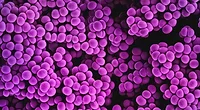Light-Based Pathogen Detection Method Can Give Results for Multiple Pathogens in One Hour

Credit: Sean Sinclair via Unsplash
Scientists from Osaka Metropolitan University in Japan have developed a rapid detection method for microbial contaminants in food that can identify the presence of certain pathogens by color. The new method allows for the simultaneous identification of multiple pathogens within just one hour.
The new technology uses the optical properties of organic, metal nanohybrid structures (NHs) of polymer-coated metal nanoparticles (NPs), which reflect scattered light that is stable in the air for long periods of time and can therefore serve as effective labeling materials. NHs reflect different colors based on the metal elements of their NPs; gold, silver, and copper scatter white, red, and blue light, respectively.
The researchers were successfully able to identify Escherichia coli O26, E. coli O157, and Staphylococcus aureus by the way that NHs, injected with antibodies that bind specifically to E. coli O26, E. coli O157, and S. aureus, respectively scattered white, red, and blue light. The new method enabled researchers to identify multiple bacteria within a single field of view under a dark-field microscope, and it can allow for the identification of various types of bacteria by introducing different antibodies to the NHs.
Because the new technology does not require bacterial culturing, it can produce results in as little as one hour, which is a vast improvement from traditional methods than can take up to 48 hours to detect the presence of a pathogen. The simple and rapid nature of the new method, in addition to the fact that it can allow for the simultaneous detection of multiple bacteria, makes it a promising tool for food manufacturing facilities.
Looking for quick answers on food safety topics?
Try Ask FSM, our new smart AI search tool.
Ask FSM →








